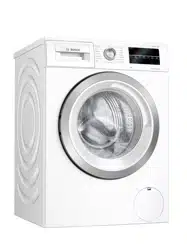Documents: Go to download!
User Manual
- User Manual - (English)
- Energy Label - (English)
- Data Sheet - (English)
- Product Information - (English)
- Installation and connection
- Contents of package
- Removing the transit bolts
- Aligning the appliance
- Starting an empty washing cycle
- Detergents and care products
- Basic operation
- Cleaning and servicing
- Cleaning the drain pump
- Clean the water inlet filters.
- Troubleshooting
Table of contents
User manual Washing Machine for Bosch WAU28T64GB
Installation and connection
Unpacking the appliance
Note: Please read the information in the "Safety" → Page 4 and "Prevent- ing material damage" → Page 11 sec- tions to ensure that you use the appli- ance safely.
- Remove any packaging and pro- tective covers completely from the appliance. For the environmentally friendly disposal of the packaging materi- als, observe the information on the topic of → "Disposing of packaging", Page 12.
- Check the appliance for visible damage.
- Open the door.
- Remove the accessory from the drum.
- Close the door.
Contents of package
After unpacking all parts, check for any damage in transit and completeness of the delivery.

 Washing machine
Washing machine
 Accompanying documents
Accompanying documents
 Water inlet hose
Water inlet hose
 Cover caps
Cover caps
Removing the transit bolts
The appliance is secured for trans- portation using transit bolts on the rear of the appliance.
Notes
- Please read the information in the "Safety" → Page 4 and "Preventing material damage" → Page 11 sec- tions to ensure that you use the appliance safely.
- Keep the transit bolts, screws and sleeves in a safe place for future "transport" → Page 55.
1. Pull the hoses out of the holders.
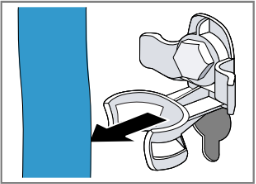
2. Unscrew (1) and remove (1) all four screws for the transit bolts with a WAF 13 wrench.

3. Pull the power cord out of the holder.

4. Remove the four sleeves.

5. Put on the four cover caps.
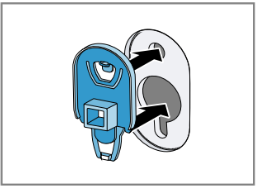
6. Press down on the four cover caps.

Connecting the water inlet hose
Note
Please read the information in the "Safety" → Page 4 and "Preventing material damage" → Page 11 sec- tions to ensure that you use the appliance safely.
1. Connect the water inlet hose.

2. Connect the water inlet hose to a tap (26.4 mm = 3/4").
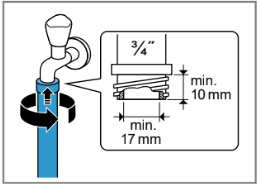
3. Open the water tap carefully and check that the connection points are tight.
Aligning the appliance
In order to reduce noise and vibra- tion and to prevent the appliance from moving, align the appliance cor- rectly.
Note: Please read the information in the "Safety" → Page 4 and "Prevent- ing material damage" → Page 11 sec- tions to ensure that you use the appli- ance safely.
1. Loosen the lock nuts using a WAF17 wrench by turning it in a clock- wise direction.

2. To align the appliance, turn the ap- pliance feet. Check that the appli- ance is level using a spirit level.
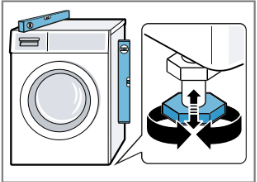
All appliance feet must stand firmly on the ground.
3. Screw the lock nuts tightly against the housing using a WAF 17 wrench.
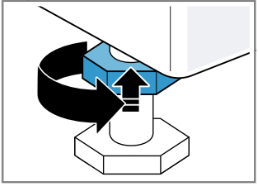
In doing so, hold the foot tight and do not adjust its height.
Connecting the appliance to the electricity supply
Note: Please read the information in the "Safety" → Page 4 and "Prevent- ing material damage" → Page 11 sec- tions to ensure that you use the appli- ance safely.
- Insert the mains plug of the appli- ance's power cable in a socket nearby. The connection details of the appli- ance can be found under "Tech- nical data" → Page 58.
- Check the mains plug is inserted properly.
Starting an empty washing cycle
Your appliance was inspected thor- oughly before leaving the factory. To remove any residual water, run the first wash cycle without any laundry.
Note: Please read the information in the "Safety" → Page 4 and "Prevent- ing material damage" → Page 11 sec- tions to ensure that you use the appli- ance safely.
- Turn the programme selector to Drum Clean.
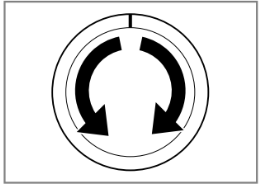
- Close the door.
- Pull out the detergent drawer.
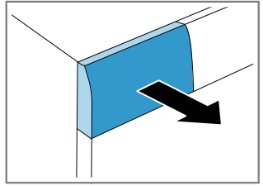
- Pour washing powder into com- partment II.
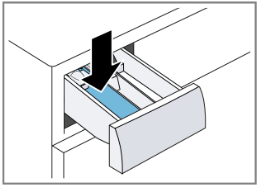
To prevent foaming, use only half of the amount of detergent recom- mended by the detergent manufac- turer for light soiling. Do not use detergent suitable for woollens or delicates.
- Push in the detergent drawer.
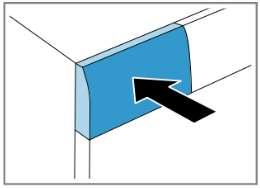
- Press Start/Reload to start the programme.
Start the first wash cycle or set the programme selector to Off to switch off the appliance.
Detergents and care products
You can protect your appliance and your laundry by selecting and using the correct detergents and care products. You can use all detergents and care products which are suitable for domestic washing machines.
Note: Please read the information in the "Safety" → Page 4 and "Prevent- ing material damage" → Page 11 sec- tions to ensure that you use the appli- ance safely.
The manufacturer's instructions for use and dosage can be found on the packaging.
Notes
- Only use liquid detergents that are self-flowing
- Do not mix different liquid deter- gents
- Do not mix detergent and fabric softener
- Do not use products that have ex- pired or are highly congealed.
- Do not use products containing solvents, caustic agents or volatile substances (e.g. bleach)
- Use dyes sparingly as salt may damage stainless steel
- Do not use bleaching agents in the appliance
Detergent recommendation
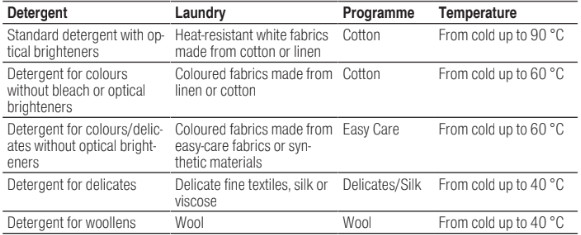
Basic operation
Setting a programme
- Set the programme selector to the required "programme" → Page 24.

- If necessary, "adjust the pro- gramme settings" → Page 35.
Adjusting the programme settings
- Depending on the programme and programme progress, you can adjust or activate/deactivate the settings.
Note: Overview of all programme set- tings: → "Buttons", Page 23
Requirement: A programme has been set.
Adjust the programme settings. The programme settings are not saved permanently for the pro- gramme.
Loading laundry
1. Open the door.
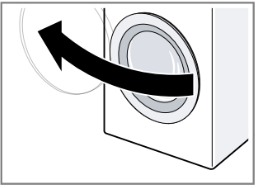
2. Ensure that the drum is empty.
3. Separate the laundry and place it in the drum.
4. Note: Ensure that there is no laun- dry trapped in the door.
Close the door.
Using a measuring aid for li- quid detergent
If you order the measuring aid as an accessory, you must use the measur- ing aid.
1. Pull out the detergent drawer.

2. Press down on the insert and re- move the detergent drawer.
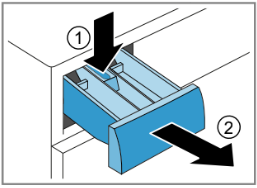
3. Insert the measuring aid.
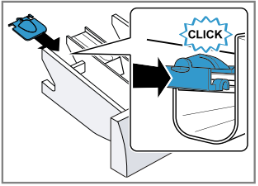
4. Insert the detergent drawer.
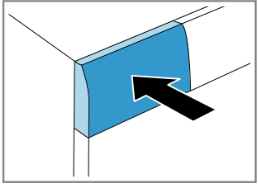
Use the measuring aid for li- quid detergent
To add liquid detergent, you can use a measuring aid in the detergent drawer.
1. Pull out the detergent drawer.
2. Slide the measuring aid forwards.
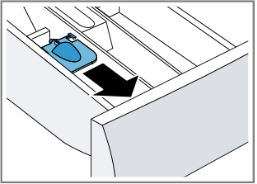
3. Fold the measuring aid down and click it into place.

4. Push in the detergent drawer.
Adding detergent and care product
Notes
- Please read the information in the "Safety" → Page 4 and "Preventing material damage" → Page 11 sec- tions to ensure that you use the appliance safely.
- Do not use the measuring aid for liquid detergent for gel detergents, washing powder, or if Prewash or "Ready in" time are activated.
Requirement: Find out the optimum dosage for "detergent and care product." → Page 33
- Pull out the detergent drawer.
- Pour in detergent. → "Detergent drawer", Page 20
- If required, add the care product.
- Push in the detergent drawer.
Starting the programme
Note: If you want to change the time until the programme ends, set the "Ready in" time first.
Press Start/Reload.
- The drum rotates and load detec- tion takes place. This can take up to 2 minutes, after which water enters the drum.
- The display shows either the pro- gramme duration or the "Ready in" time.
- After the programme has ended, the display shows: End.
Adjusting the "Ready in" time before the programme starts
You can readjust the selected "Ready in" time before the programme starts.
- Press Start/Reload.
- Press Finish in repeatedly until the display indicates the desired "Ready in" time.
- Press Start/Reload.
Adding laundry
Note: Please read the information in the "Safety" → Page 4 and "Prevent- ing material damage" → Page 11 sec- tions to ensure that you use the appli- ance safely.
- Press Start/Reload. The appliance is paused and checks whether it is possible to add or remove laundry. Take note of the programme status.
- Add or remove laundry.
- Close the door.
- Press Start/Reload.
Cancelling the programme
Once the programme has started, you can cancel it at any time.
Note: Please read the information in the "Safety" → Page 4 and "Prevent- ing material damage" → Page 11 sec- tions to ensure that you use the appli- ance safely.
- Press Start/Reload.
- Open the door. The appliance door remains locked for safety reasons if the temperature and water levels are high.
If the temperature is high, start the Rinse programme.
If the water level is high: Start the Spin or Drain programme.
- Remove the laundry.
Resuming the programme when the programme status is Rinse Hold
- Set the Spin or Drain programme.
- Press Start/Reload.
Unloading the laundry
Note: Please read the information in the "Safety" → Page 4 and "Prevent- ing material damage" → Page 11 sec- tions to ensure that you use the appli- ance safely.
- Open the door.
- Remove the laundry.
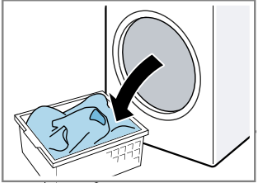
Switching off the appliance
- Turn the programme selector to Off.

- Turn off the tap.
- Wipe the rubber gasket dry and re- move any foreign objects.
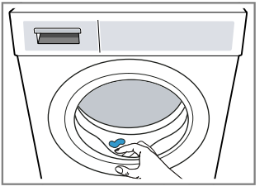
- Leave the door and detergent drawer open so that residual water can evaporate.
Changing the basic settings
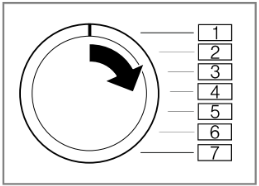
- Set the programme selector to po- sition 1.
- Press Spin Speed and, at the same time, turn the programme selector to position 2. The display shows the current value.
- Set the programme selector to the required position.
- To change the value, press Finish in.
- To save the changes, switch off the appliance.
Cleaning and servicing
To keep your appliance working effi- ciently for a long time, it is important to clean and maintain it carefully.
Tips on appliance care
Follow the tips for appliance care to ensure your appliance works cor- rectly in the long term.
- Wipe down the hous- ing and the control panel with nothing but water and a damp cloth.
The appliance parts remain clean and hy- gienic.
- Remove all detergent residue, spray residue or other residues im- mediately.
Fresh deposits are easier to remove without leaving any residue.
- Keep the appliance door and detergent drawer open after use.
This allows the resid- ual water to dry, redu- cing odours in the ap- pliance.
Cleaning the drum
If you often wash at a washing tem- perature of 40 °C and lower or the appliance has not been used for a long period, clean the drum.
Permanently washing at low temper- atures and a lack of ventilation for the appliance may damage the drum and cause injury.
- Regularly run a programme for cleaning the drum or wash at tem- peratures of at least 60 °C.
- Leave the appliance to dry after every operation with the door open, and leave the detergent drawer to dry.
- Run the Drum Clean programme without laundry.
Add washing powder.
Cleaning the detergent drawer
Note: Please read the information in the "Safety" → Page 4 and "Prevent- ing material damage" → Page 11 sec- tions to ensure that you use the appli- ance safely.
- Pull out the detergent drawer.
- Press down on the insert and re- move the detergent drawer.

- Press out the insert upwards from below.
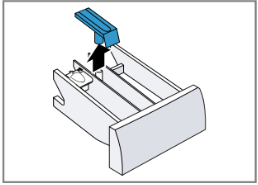
- Clean the detergent drawer and in- sert with water and a brush, and then dry them.
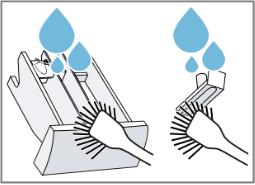
- Fit the insert and lock it into place.
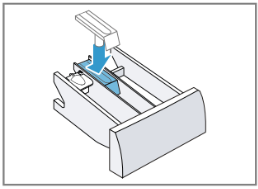
- Cleaning the opening for the deter- gent drawer.
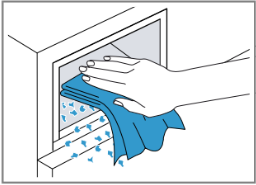
- Push in the detergent drawer.
Cleaning the drain pump
Clean the drain pump in the event of faults, e.g. blockages or rattling noises.
Emptying the drain pump
Note: Please read the information in the "Safety" → Page 4 and "Prevent- ing material damage" → Page 11 sec- tions to ensure that you use the appli- ance safely.
- Turn off the water tap.
- Switch off the appliance.
- Disconnect the appliance's mains plug from the power supply.
- Open the maintenance flap.
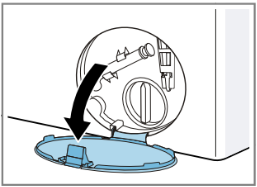
- Remove the maintenance flap.

- Slide a sufficiently large receptacle under the opening.
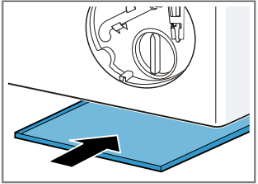
- Take the drain hose out of the holder.

When you wash at high temperat- ures, the detergent solution gets hot.
Do not touch the hot detergent solution.
To allow the detergent solution to flow out into the container, remove the sealing cap.
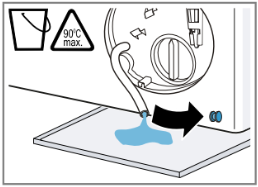
Firmly press on the sealing cap.
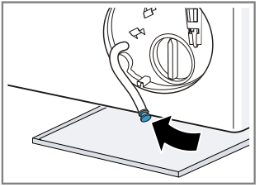
Insert the drain hose into the holder.
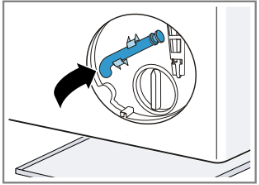
Cleaning the drain pump
Note: Please read the information in the "Safety" → Page 4 and "Prevent- ing material damage" → Page 11 sec- tions to ensure that you use the appli- ance safely.
Requirement: "The drain pump is empty." → Page 42
- Since water may remain in the drain pump, remove the pump cap carefully.
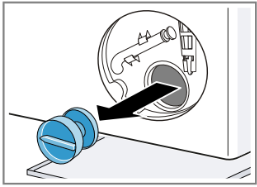
- Clean the interior, the thread on the pump cap and the pump hous- ing.

- Make sure that the impeller in the drain pump can be rotated.
- Insert the pump cap and screw it on as far as it will go.
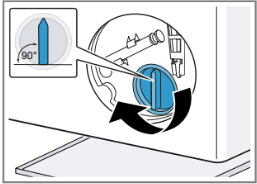
The handle on the pump cap must be in a vertical position.
- Insert the maintenance flap and lock it into place.
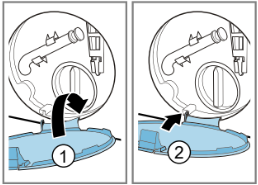
- Close the maintenance flap.
Cleaning the water outlet hose at the siphon
If the water outlet hose at the siphon is dirty or the detergent solution is not being pumped out, you must clean these.
- Switch off the appliance.
- Disconnect the appliance's mains plug from the power supply.
- Loosen the hose clamp and care- fully remove the water outlet hose.

Residual water may leak out.
- Clean the water outlet hose and si- phon connecting piece.

- Reattach the water outlet hose and secure the connection point using the hose clamp.
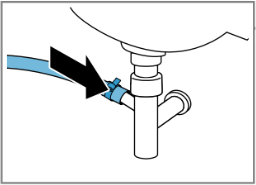
Clean the water inlet filters.
Clean the filter in the water inlet in the event of blockages or if the water pressure is too low.
Emptying the water inlet hose
- Turn off the tap.
- Set a programme, except for Rinse, Spin or Drain.
- Start the programme and leave it to run for approx. 40 seconds.
- Switch off the appliance.
- Disconnect the appliance's mains plug from the power supply.
Cleaning the filter on the tap
Note: Please read the information in the "Safety" → Page 4 and "Prevent- ing material damage" → Page 11 sec- tions to ensure that you use the appli- ance safely.
Requirement: The water inlet hose is empty.
- Remove the water inlet hose from the tap.
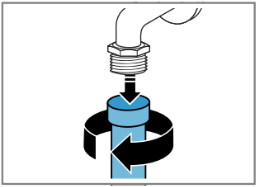
- Clean the filter with a small brush.

- Connect the water inlet hose and check for leaks.
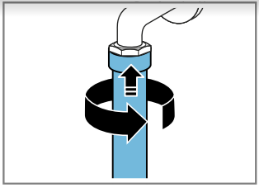
Cleaning the filter on the appliance
Note: Please read the information in the "Safety" → Page 4 and "Prevent- ing material damage" → Page 11 sec- tions to ensure that you use the appli- ance safely.
Requirement: The water inlet hose is empty. → "Emptying the water inlet hose", Page 45
- Disconnect the hose from the rear of the appliance.
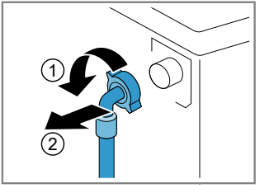
- Use pliers to remove the filter.
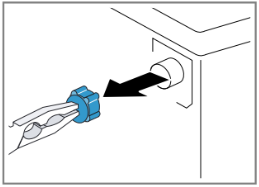
- Clean the filter with a small brush.
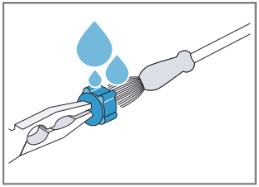
- Reinsert the filter.
- Connect the hose and check for leaks.

Troubleshooting
You can rectify minor faults on your appliance yourself. Read the troubleshoot- ing information before contacting after-sales service. This will avoid unneces- sary costs.
The display goes out and Start/Reload flashes.
- Energy-saving mode is active
Press any button.
The symbol lights up again.
"E:36 / -10"
- Drain pipe or water outlet hose is blocked.
Clean the drain pipe and the water outlet hose.
- Drain pipe or water drain hose is caught or jammed.
Ensure that the drain pipe and wa- ter drain hose are not kinked or trapped.
- Drain pump is blocked.
Cleaning the drain pump", Page 42
- The water outlet hose is con- nected too high.
Install the water outlet hose at a maximum height of 1 metre.
- Detergent dosage is too high.
Immediate measure: Mix one table- spoon of fabric softener with 0.5 litres of water and pour the mixture into the left-hand compartment (not for outdoor clothing, sportswear or items stuffed with down).
Reduce the amount of detergent for the next washing cycle with the same load.
- Unapproved extension in- stalled on the water drain hose.
Remove any unapproved exten- sions from the water hose. Connect- ing the appliance
"E:36 / -25 / -26"
- Drain pump is blocked.
→ "Cleaning the drain pump", Page 42

- The water pressure is low.
No remedial action possible.
- The filters in the water inflow are blocked.
Clean the filters in the water in- flow" → Page 45.
- The tap is turned off.
Turn on the tap.
- The water inlet hose is kinked or jammed.
Ensure that the water inlet hose is not kinked or jammed.
: flashes.
- The automatic voltage con- trol system detects an unau- thorised voltage under-us- age.
No remedial action possible.
Note: If the power supply is stable, the programme continues to run as nor- mal.
- Voltage under-usage may cause extension of a pro- gramme.
No remedial action possible.
. flashes.
- Voltage under-usage may cause extension of a pro- gramme.
No remedial action possible.
 lights up.
lights up.
- The temperature is too high.
Wait until the temperature has dropped.
Cancelling the programme", Page 37
- Water level is too high.
Start the Drain programme.
- Laundry is caught in the door.
1. Open the door again.
2. Remove any trapped laundry.
3. Close the door.
4. Press Start/Reload to start the pro- gramme.
 flashes.
flashes.
- Door is not closed.
1. Close the door.
2. Press Start/Reload to start the pro- gramme.
All other error codes.
- Malfunction
Call the after-sales service. → "Customer Service", Page 57
The appliance is not working.
- The mains plug of the power cord is not plugged in.
Connect the appliance to the power supply.
- The circuit breaker is faulty.
Check the circuit breaker in the fuse box.
The appliance is not working.
- There has been a power cut.
Check whether the lighting in your kitchen or other appliances are working.
The water is not draining.
- Drain pipe or water outlet hose is blocked.
Clean the drain pipe and the water outlet hose.
- Drain pipe or water drain hose is caught or jammed.
Ensure that the drain pipe and wa- ter drain hose are not kinked or trapped.
- Drain pump is blocked.
→ "Cleaning the drain pump", Page 42
The spin cycle runs several times.
- The unbalanced load detec- tion system eliminates an im- balance by repeatedly redis- tributing the laundry.
Not a fault – no action required.
Note: When loading, where possible, place large and small items of laundry together in the drum. Different sized items of laundry distribute themselves better during the spin cycle.
The programme duration changes during the wash cycle.
- The programme operation is optimised electronically. This may change the pro- gramme duration.
Not a fault – no action required.
- The unbalanced load detec- tion system eliminates an im- balance by repeatedly redis- tributing the laundry.
Not a fault – no action required.
High spin speed not reached.
- Unbalance load detection system is using a reduced spin speed to eliminate an unbalance.
Redistribute the laundry in the drum.
Note: Where possible, mix large and small items in the drum. Different sized items of laundry distribute themselves better during the spin cycle.
Start the Spin programme.
The spin programme does not start.
- Drain pipe or water outlet hose is blocked.
Clean the drain pipe and the water outlet hose.
- Drain pipe or water drain hose is caught or jammed.
Ensure that the drain pipe and wa- ter drain hose are not kinked or trapped.
- The unbalanced load detec- tion system has interrupted the spin cycle because the laundry is unevenly distrib- uted.
Redistribute the laundry in the drum.
Note: Where possible, mix large and small items in the drum. Different sized items of laundry distribute themselves better during the spin cycle.
Start the Spin programme.
Rushing, hissing noise.
- Water is flushed under pres- sure into the detergent drawer.
Not a fault – normal operating noise.
Loud noises during the spin cycle.
- Appliance is not correctly aligned.
Aligning the appliance
- The appliance feet are not fixed.
Secure the appliance feet. Aligning the appliance
- Transit bolts have not been removed.
Removing the transit bolts
Banging noises, rattling in the drain pump.
- Foreign bodies have got into the drain pump.
→ "Cleaning the drain pump", Page 42
Slurping, rhythmical suction noise.
- The drain pump is active, the detergent solution is pumped out.
Not a fault – normal operating noise.
Creasing.
- The wrong programme is se- lected for the type of fabric.
Select the programmes that are suitable for the type of fabric. → "Programmes", Page 24
Detergent or fabric softener drips off the seal and col- lects on the door or in the seal fold.
- Too much detergent/fabric softener in the detergent drawer.
When dosing liquid detergent and fabric softener, observe the mark- ing in the detergent drawer and do not dose above this.
The spin result is not satis- factory. The laundry is too wet/too damp.
- A low spin speed is selected.
The next time you run a wash cycle, set a higher spin speed.
Start the Spin programme.
Detergent residue on the damp washing.
- Detergents may contain wa- ter-insoluble substances that deposit on the laundry.
Start the Rinse programme.
Detergent residue on the dry laundry.
- Detergents may contain wa- ter-insoluble substances that deposit on the laundry.
Brush out the laundry after washing and drying.
See other models: WAU28TS1GB WAU28R90GB WAU28PH9GB WAV28MH3GB WIW28301GB
